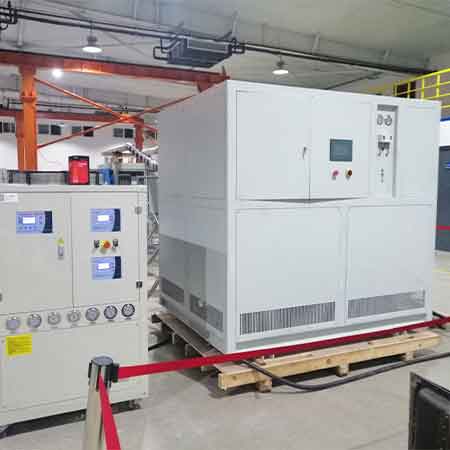Refrigerant Chillers
Kontaktieren Sie uns noch heute für die perfekte Lösung zur Temperaturkontrolle
The basic principle of refrigerant chillers is to use the conversion of refrigerant between liquid and gaseous states to absorb and release heat. The refrigerant absorbs heat and evaporates in the evaporator, turning into a gaseous state. It is then sucked into the compressor and compressed into a high-pressure gas. It then releases heat and liquefies through the condenser, turning into liquid refrigerant. Finally, it returns to the evaporator through the throttle valve. Complete a cycle. During this cycle, the heat absorbed and released by the refrigerant is used to lower the temperature of the object.
Refrigerant chillers are mainly composed of refrigerant, compressor, condenser, throttle valve and evaporator. Refrigerant is one of the most important components of a chiller, converting between liquid and gaseous states, absorbing and releasing heat. The compressor is a device that sucks refrigerant from the evaporator and compresses it into high-pressure gas. The condenser is a device that releases heat and liquefies the refrigerant from the gas state. The throttle valve is a device that controls the flow of refrigerant to the evaporator, which is where the refrigerant absorbs heat and evaporates.

Application range of refrigerant chillers
1. Air conditioning system
Refrigerant chillers are one of the core components of air conditioning systems. They can provide cold water in public places such as large office buildings, shopping malls, hotels, airports, subways, etc., so that these places can bring coolness to people in summer and improve people’s life and work. efficiency.
2. Medical equipment
Medical equipment usually requires a large amount of refrigeration processing to ensure the normal use of diagnostic and treatment equipment. It also requires cold therapy, body temperature control, etc. for patients, all of which require chillers to provide refrigeration effects.
3. Mining and metallurgy
In the mining and metallurgical industry, many equipment need to be cooled to ensure production efficiency and quality, and refrigerant chillers can provide cooling and heat preservation effects for these equipment, and can also prevent overheating of furnaces and other equipment in summer.
4. Electric power industry
In the power industry, generators need to dissipate a large amount of heat and require cooling water to maintain normal operation. Refrigerant chillers can provide sufficient cooling technology for generators and play an important role in the power industry.
5. Lebensmittelverarbeitung
The refrigeration process in the food processing industry also requires the use of chillers for cooling to ensure the quality of processed products. Refrigerant chillers play an important role in food processing.
Wir bieten die Entwicklung und Herstellung kompletter Temperaturkontrollsysteme an. Von Standardmodellen bis zu kompletten kundenspezifischen Produkten bis hin zu 900 Tonnen. Wir haben uns auf den Kundenservice spezialisiert und sind bestrebt, jedem Kunden zu helfen, das optimale Temperaturkontrollsystem für seinen spezifischen Bedarf zu finden.
Wir bieten maßgeschneiderte Lösungen, die nicht dem Standard entsprechen. Es sind sowohl einzelne Kühlaggregate als auch kombinierte Kühl- und Heizaggregate erhältlich.
E-Mail: info@lneya.com WeChat ID: +8615251628237 WhatsApp: +86 17851209193

Rückkühler / Umwälzkühler
Die Kältemaschine kann in verschiedenen Industrien und Labors eingesetzt werden und unterstützt kundenspezifische Designs.
| Temperaturbereich | Serie -25°C ~ +30°C | -45°C ~ +30°C Reihe | Serie -60°C ~ -20°C | Serie -80°C ~ -20°C | Serie -120°C ~ -70°C | ||||
| Kühlleistung | 0,8 ~ 30kW | 0,75 ~ 12kW | 0,4 ~ 6kW | 0,2 ~ 6kW | 0,3 ~ 5kW | ||||
| Hinweis: Jeder Temperaturbereich von -150℃ ~ +350℃ und jede Kühlleistung kann angepasst werden | |||||||||
 Kaltwassersätze / Kleinkaltwassersätze
Kaltwassersätze / Kleinkaltwassersätze
Die Kältemaschine kann in verschiedenen Industrien und Labors eingesetzt werden und unterstützt kundenspezifische Designs.
| Temperaturbereich | -18°C ~ +30°C | +5°C ~ +35°C Reihe | |||||||
| Kühlleistung | 0,35 ~ 0,9kW | 1,8 ~ 50kW | |||||||
| Hinweis: Jeder Temperaturbereich von -150℃ ~ +350℃ und jede Kühlleistung kann angepasst werden | |||||||||

Niedertemperatur-Kühlgeräte
Wir haben uns auf die Herstellung von Niedertemperaturkältemaschinen mit einem Temperaturregelbereich von bis zu -150°C spezialisiert, die den Kühlbedarf verschiedener Branchen decken.
| Temperaturbereich | Serie -25°C ~ -5°C | Serie -45°C ~ -10°C | Serie -60°C ~ -10°C | Serie -80°C ~ -30°C | Serie -110°C ~ -50°C | Serie -150°C ~ -110°C | |||
| Kühlleistung | 12 ~ 360kW | 6 ~ 180kW | 6 ~ 180kW | 4 ~ 180kW | 2 ~ 120kW | 2,5 ~ 11kW | |||
| Hinweis: Jeder Temperaturbereich von -150℃ ~ +350℃ und jede Kühlleistung kann angepasst werden | |||||||||
Kühlen und Heizen Kaltwassersätze

Kühlen und Heizen Kaltwassersätze
Temperaturregelbereich: -120°C bis +350°C
Kühl- und Heizungsthermostate, die in verschiedenen Industriezweigen weit verbreitet sind.
| Temperaturbereich | Serie -10 ~ +150°C | Serie -25 ~ +200°C | Serie -25 ~ +300°C | Serie -45 ~ +250°C | Serie -45 ~ +300°C | Serie -60 ~ +250°C | Serie -60 ~ +300°C | Serie -70 ~ +250°C | Serie -80 ~ +250°C | Serie -90 ~ +250°C | Serie -100 ~ +100°C | ||
| Kühlleistung | 1,5 ~ 15kW | 1 ~ 200kW | 1 ~ 200kW | 0,45 ~ 200kW | 0,9 ~ 25kW | 0,25 ~ 60kW | 0,75 ~ 25kW | 0,4 ~ 15kW | 0,3 ~ 80kW | 0,2 ~ 80kW | 0,45 ~ 80kW | ||
| Hinweis: Jeder Temperaturbereich von -150℃ ~ +350℃ und jede Kühlleistung kann angepasst werden | |||||||||||||

Kühlgeräte mit Rücklaufheizung
Temperaturregelbereich: -45°C bis +250°C
| Temperaturbereich | Serie -25°C ~ +200°C | Serie -45°C ~ +250°C | |||||||
| Kühlleistung | 1 ~ 15kW | 0,25 ~ 15kW | |||||||
| Hinweis: Jeder Temperaturbereich von -150℃ ~ +350℃ und jede Kühlleistung kann angepasst werden | |||||||||
 LNEYA
LNEYA
 简体中文
简体中文


















































































